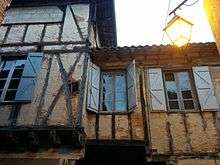Lisle-sur-Tarn
Lisle-sur-Tarn is a commune in the Tarn department in southern France.
Lisle-sur-Tarn | |
|---|---|
.jpg) The main square in Lisle-sur-Tarn | |
.svg.png) Coat of arms | |
Location of Lisle-sur-Tarn 
| |
 Lisle-sur-Tarn  Lisle-sur-Tarn | |
| Coordinates: 43°51′16″N 1°48′42″E | |
| Country | France |
| Region | Occitanie |
| Department | Tarn |
| Arrondissement | Albi |
| Canton | Vignobles et Bastides |
| Intercommunality | Tarn and Dadou |
| Government | |
| • Mayor (2014-2020) | Maryline Lherm |
| Area 1 | 86.56 km2 (33.42 sq mi) |
| Population (2017-01-01)[1] | 4,694 |
| • Density | 54/km2 (140/sq mi) |
| Time zone | UTC+01:00 (CET) |
| • Summer (DST) | UTC+02:00 (CEST) |
| INSEE/Postal code | 81145 /81310 |
| Elevation | 95–285 m (312–935 ft) (avg. 127 m or 417 ft) |
| 1 French Land Register data, which excludes lakes, ponds, glaciers > 1 km2 (0.386 sq mi or 247 acres) and river estuaries. | |
Geography
The city is located halfway between Toulouse and Albi on the A68 motorway, in the Gaillac vineyard, on the banks of the Tarn. Historically speaking, it is also located on one of the ancient Ways of St. James.
History
Created as a bastide by Raymond VII, Count of Toulouse in the 13th century, after the destruction of the castel of Montagut, ordered by the crusaders during the Albigensian Crusade. Thanks to local productions such as pastel and Gaillac wine, the city became an important market with a fluvial port on the Tarn. This extensive heritage, in a region that is still producing wine nowadays, plays an important role in the local tourism-oriented economy.
Demography
| Year | 1962 | 1968 | 1975 | 1982 | 1990 | 1999 | 2007 |
|---|---|---|---|---|---|---|---|
| Population | 3308 | 3376 | 3385 | 3413 | 3588 | 3684 | 4171 |
Transport
- Gare de Lisle-sur-Tarn
Notable facts

The village was designed with perpendicular, regularized streets with red-brick half-timbered houses, that are made up of an ensemble of four districts, each one delimited by a fortified gate. The market square is the largest of all the south-western bastides, with about 5,000 m². It was renovated in 2000. The town has a museum on the main square to the artist Raymond Lafage.
Trivia
The town figures in Tracy Chevalier's novel The Virgin Blue.
References
- "Populations légales 2017". INSEE. Retrieved 6 January 2020.
- Lisle-sur-Tarn sur le site de l'Insee